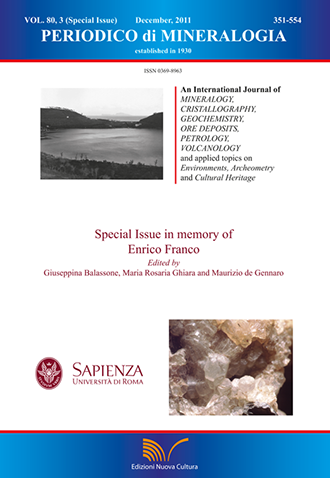Vesuvianite from Somma-Vesuvius volcano (southern Italy): chemical X-ray diffraction and single-crystal polarized FTIR investigations
DOI:
https://doi.org/10.2451/2011PM0026Keywords:
vesuvianite, Somma-Vesuvius volcano, ejecta, chemical analyses, X-ray diffraction, FTIR spectroscopyAbstract
A suite of twelve vesuviante samples from skarn and syenitc ejecta from the Somma- Vesuvius volcanic complex was studied by means of a combination of energy dispersive spectrometry (EDS), inductively-coupled plasma-mass spectrometry (ICP-MS), powder and single-crystal X-ray diffraction, polarized radiation Fourier-transform infrared (FTIR) singlecrystal micro-spectrometry. Some thermo-gravimetric analyses (TGA) were also performed. Vesuvianite crystals are dark brown to honey yellow-brown, rarely reddish-brown, and up to 2 centimetres in dimension. Their major elements (SiO2 , Al2O3, CaO and MgO) composition is rather constant, while Fe2O3, MnO and TiO2 are slightly more variable. Light elements (B, Be and Li), Y, REE and actinides (Th, U) have been detected in all samples in minor to trace amounts, together with V, Zn, Zr, Sn, Co, Ga, Nb, Ta, Hf, Pb and Bi. Among the volatiles, fluorine is prevailing (in a range 1.41-2.25 wt. %). Water and chlorine are always observed, in the range 0.67-1.03 wt. % and 0.01-0.05 wt. %, respectively. Single-crystal X-ray diffraction analyses of vesuvianite gave P4/nnc as the most probable space group. Cell parameters vary from 15.542 Å up to 15.576 Å for a and 11.800 Å up to 11.827 Å for c . Polarized FTIR spectra of the OH fundamental measured parallel to the c -axis are dominated by absorption bands at 3638, 3567, 3452 and 3200 cm-1, with two additional bands centred at 3590 and 3117 cm-1. All bands show strong pleochroism with maximum absorption parallel to the c-axis and weak absorption components perpendicular to c. The spectra measured perpendicular to the c-axis are also dominated by the 3567, 3590 and 3638 cm-1 band group. OH amounts have been calculated using the total integrated absorption coefficient derived from the fitted spectra. These contents are in good agreement with the H2O values obtained by TGA. The formation temperature and the chemical environment of vesuvianite point to at least 800-890 °C and to the occurrence of chloride-fluoride-sulfate-carbonate-rich saline fluids, which are also rich in incompatible elements.


